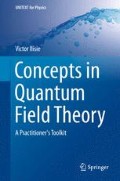Abstract
In this chapter we present a few relevant calculations of one-loop, one and two-point (scalar, vector and tensor) functions. IR and UV divergences are extensively treated. One example of IR-pole cancellation is presented. The two and three-body phase space integrals in D dimensions, needed for the calculation of IR divergent cross sections are also given. Last, the usage of the generic parametrization (6.27) for non-integer powers of propagators (which appear when one needs to integrate over the four-momentum, logarithmic functions that depend on the four-momentum) is shown with a simple two-loop example. With the tools given here, the reader should find straightforward to construct any higher order scalar or tensor integral for any N-point function at one-loop level.
Access this chapter
Tax calculation will be finalised at checkout
Purchases are for personal use only
Notes
- 1.
The QED Feynman rules are given in Chap. 5.
- 2.
As the photon is not a real (on-shell) particle we shall not average over its polarizations when calculating the cross section.
- 3.
- 4.
For a complete set of Feynman rules for the Standard Model read J. C. Romao and J. P. Silva, A resource for signs and Feynman diagrams of the Standard Model, Int. J. Mod. Phys. A 27 (2012) 1230025, http://arxiv.org/pdf/1209.6213.pdf.
.
- 5.
Here we have used \(g/2=M_W/v\) and \(e=g \, s_\text {w}\).
- 6.
Further Reading
A. Pich, Quantum Chromodynamics, http://arxiv.org/pdf/hep-ph/9505231v1.pdf
V. Ilisie, New Barr-Zee contributions to \((g-2)_\mu \) in two-Higgs-doublet models. JHEP 04, 077 (2015), http://arxiv.org/pdf/1502.04199v3.pdf
M. Kaku, Quantum Field Theory: A Modern Introduction
M. Srednicki, Quantum Field Theory
S. Pokorsky, Gauge Field Theories
G. Dissertori, I.G. Knowles, M. Schmelling, Quantum Chromodynamics.
T. Muta, Foundations of Quantum Chromodynamics
M.E. Peskin, D.V. Schroeder, An Introduction to Quantum Field Theory
J.C. Romao, J.P. Silva, A resource for signs and Feynman diagrams of the standard model. Int. J. Mod. Phys. A 27, 1230025 (2012), http://arxiv.org/pdf/1209.6213.pdf
L.H. Ryder, Quantum Field Theory (Cambridge University Press, Cambridge, 1985)
T.P. Cheng, L.F. Li, Gauge Theory of Elementary Particle Physics (Oxford University Press, Oxford, 1984)
F. Mandl, G.P. Shaw, Quantum Field Theory
Author information
Authors and Affiliations
Corresponding author
Rights and permissions
Copyright information
© 2016 Springer International Publishing Switzerland
About this chapter
Cite this chapter
Ilisie, V. (2016). One-Loop Two and Three-Point Functions. In: Concepts in Quantum Field Theory. UNITEXT for Physics. Springer, Cham. https://doi.org/10.1007/978-3-319-22966-9_8
Download citation
DOI: https://doi.org/10.1007/978-3-319-22966-9_8
Published:
Publisher Name: Springer, Cham
Print ISBN: 978-3-319-22965-2
Online ISBN: 978-3-319-22966-9
eBook Packages: Physics and AstronomyPhysics and Astronomy (R0)

